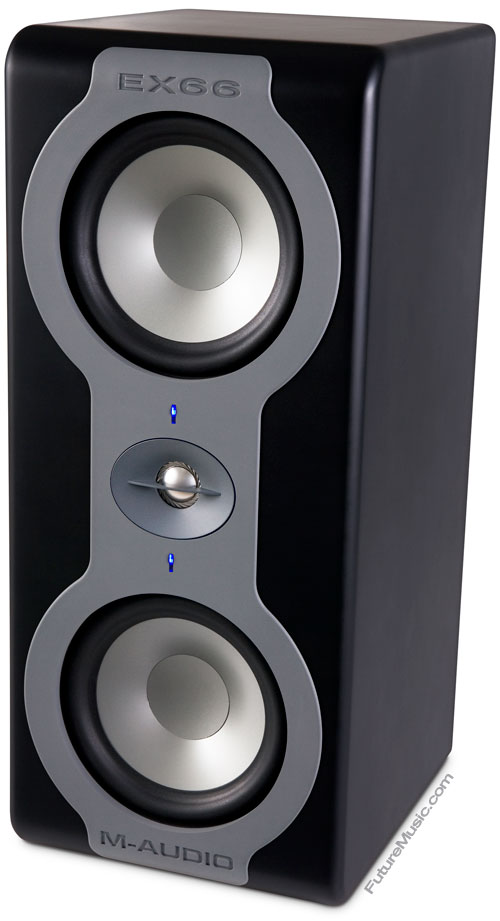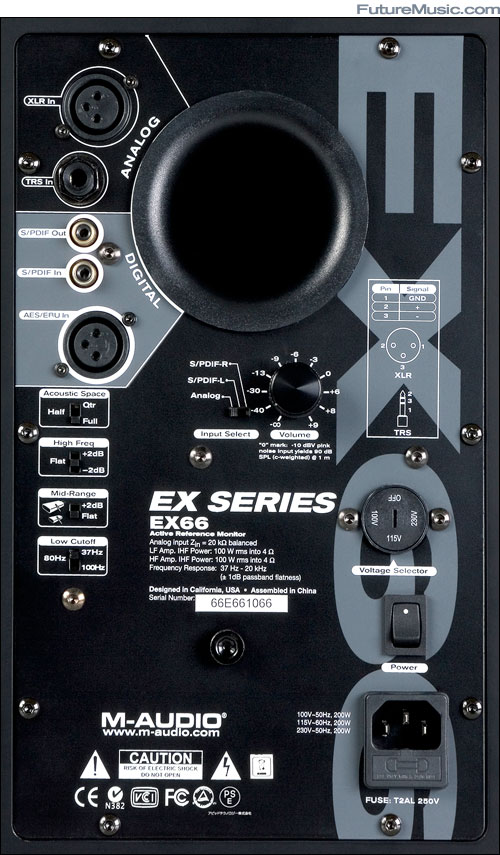|
|
|
|
|
|
|
|
|
|
|
|
|
||||||||||||||||||
|
|
|||||||||||||||||||
|
|
|
|
|
April 28, 2008 ../ TestDrive: M-Audio EX66 MonitorsI'll let you in on a little secret, one of our favorite bits of kit to review are studio monitors. Why? Well, thanks to our collaborative review process, some of our most heated, yet thoroughly entertaining, debates center around this vital studio component. Even though the evaluation of monitors is subjective at best, the criteria for what makes a good pair of monitors is relatively simple. Does the mix you've created in your studio translate in the real world?
 The one-inch, titanium-dome tweeter is located between the identical six inch, bass / mid-range drivers and is housed behind a shaped waveguide to maintain the vertical and horizontal dispersion angles at the crossover frequency point. This layout is sometimes referred to as a midwoofer-tweeter-midwoofer configuration, or MTM. The monitors are meant to be positioned vertically, not horizontally, with plenty of room needed behind the speakers due to the rear bass exhaust port. This poses some problems in studios that have decks with monitor seats built-in, or non adjustable stands, since the monitors are tall at 19 inches. M-Audio advises such positioning to narrow the sweet spot and to prevent the room's acoustics from significantly impeding the monitor's capabilities.
Features:
With the EX66, M-Audio has introduced their own proprietary driver technology that utilzes an onboard digital signal processor instead of analog circuitry found in most monitors. This allows the concern to dial in the Infinite Impulse Response filters to combat problematic cabinent resonances that they feel are detrimental. However, the signal is forced through an Analog to Digital To Analog conversion, which proved problematic for many of the evaluators — more on this later.
The EX66's are bi-amped with two individual 100-watt Pulse Width Modulation (PWM) power amps to power the 4-ohm midwoofers and 4-ohm tweeter, which is certainy more than the tweeter requires, but who's complaining.
Although, we're wary of the monitors' converters due to the EX66's price point, the S/PDIF receiver can lock to an incoming clock of up to 216kHz, and the digital input can support a sample rate up 24-bit/192kHz, but is hard set at 24-bit/96kHz when the analog inputs are being utilized. Intelligent connectivity selectors specify left channel, right channel or stereo for the digital input.
The SoundSo how do the EX66's sound? Every one of the evaluators noticed that the EX66's produced a surprising amount of noise. We contacted two retailers about the issue who confirmed the problem with a simple "this isn't the first time we've heard that..." and M-Audio acknowledged a certain level of audible hiss. The problem appears to stem from the internal DSP processing, as well as the A/D and D/A conversion. Although, the issue never became a serious irritant when mixing, it definitely needs to be addressed by M-Audio.
 The EX66's high-end "had a bit of a bite" according to most of the evaluators, which some classified as "brassy" or "shrill." However, one tester found that the EX66's high-end prominence "helped the mixing process by forcing me not to over-hype the high-end." The "hit" is most likely due to the inherent nature of the titanium in the tweeter, which put them "right up front." The dual mid-range woofers provided plenty of bass, which most of the testers had to spend "some time dialing in," but with the "plethora of bass management options" most testers were "pleased with the results." Once the bass was tuned, a couple of the testers noted the "excellent definition and detail of individual tracks" even with a "mid-range scoop." Stereo imaging was somewhat of a issue for a couple of testers and a major problem for another. The narrow width, coupled with the height of the monitors are a question, since they are somewhat unwieldy for some studio environments. As stated before, for users who have limited adjustable stands or mixing on a desk, the monitor's height will be a hornets' nest. In addition, the speakers configuration narrows the stereo sweet spot, and moving your position will cause changes in the overal tonal quality. One tester attempted to rectify the problem by setting the monitors on their side, in the horizontal position, but "immediately ran into phasing problems" in his nearfield location.
On the minus side, none of the evaulators found the EX66's pleasurable for extended periods of mixing. "Although the separation of sounds is excellent for monitoring, the metallic quality of the upper mids would begin to grate on me after a while." The majority of testers found that it took a substantial amount of time to "settle into the EX66's" to achieve favorable results. The noise floor will obviously be a "nuisance for users who mix in very quiet environments." While one evaluator liked how the EX66's "kept my mixes honest" and might consider them as a "second pair," nobody would choose them as their primarily monitoring solution, even at their attractive price point.
ConclusionWe like what M-Audio attempted to accomplish with the EX66 monitors. The technical progress they achieved with the monitors in terms of the MTM configuration, the DSP processing, and the speaker design, all at a palatable price point for consumers, will serve them well in the future if they continue to move forward with this series. Unfortunately, in this first incarnation, there's just too many negatives for the EX66's to become a choice monitoring solution for fastidious ears.The Future: First and foremost, if M-Audio decides to continue with this series, they needs to address the DSP noise issue. A monitor, even in this price range, cannot have a built-in white noise generator. The onboard DSP is a provocative concept, but without serious converters, it ends up being one step forward, two steps back. More mid-to-high range tuning may also help some users to eliminate some of the inbalance caused by the titanium tweeter's inherent snap.
The M-Audio EX66 Monitors retail for $699 each.
Current Street Price. More information on the M-Audio EX66 Monitors.>>> Back to Digihear?
Copyright © 2008 FUTUREMUSIC® All Rights Reserved. |
|
|
 We respect M-Audio's aspirations for their EX66 monitors in terms of the MTM configuration, the DSP processing, and the midwoofer and tweeter design, however they made too many compromises to reach their intended price point and the overall balance, neutrality and quality of the audio suffers.
|
|
|
|
|
|
|
|
|
|
|
|
|













